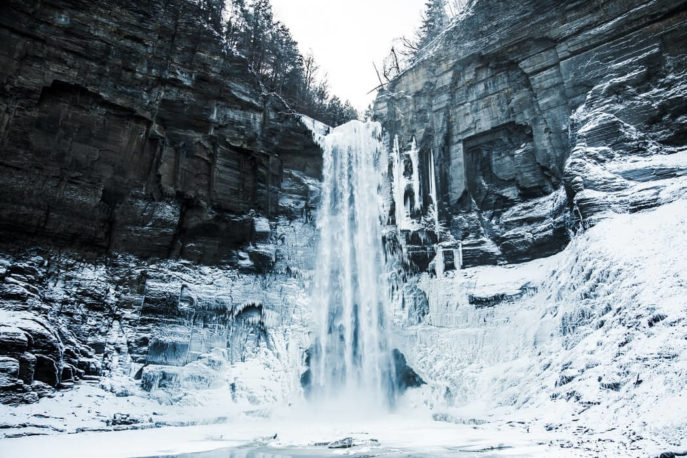Process Heaters and Freeze Prevention
Last updated on May 20th, 2025 at 04:51 am
As the cold season approaches, freeze prevention becomes a major concern for pipelines, transport, and storage. We take a look at the importance of freeze prevention, as well as how to protect equipment and materials with process heaters and other supplemental preventative strategies.
Freeze Prevention
Stored and transported liquids and gases are often in need of freeze protection, especially in cold or seasonally cold climates. Freeze prevention protects equipment, processes, and the target medium from damage or quality loss.
Freezing can cause a state change, turning liquids to solids. Even gasoline, which has an extreme freezing point (between -40℉ and -200℉) is at risk. Water condensation that gathers inside the gasoline can freeze, preventing machinery from running.
Gases can also transform into liquids if they lose enough heat. It may then change to a solid state if it freezes completely. This may affect the product’s integrity as well as presenting a hazard as the medium transform back into its original state. If sublimation occurs, this can be especially dangerous and damaging.
Even if liquids do not completely freeze, a change in temperature still affects flow rate. Changing flow rates can directly affect processes and operational efficiency.
To avoid the risks of freezing, passive and active freeze protection methods can be used. Generally, it is best to use a combination of both approaches.
Passive Freeze Prevention
Passive freeze prevention requires more planning upfront. But it can have a great, and lasting, effect with minimal ongoing efforts.
Insulation
Insulation helps to passively prevent heat loss. Proper insulation not only protects against freezing but can reduce operational costs for heating. It works in conjunction with active freeze prevention methods, such as immersion heaters. With slower and less significant heat loss, the heaters do not have to run as often or as long, keeping operational costs low.
Insulation can also help prevent freezing in a cold flash. Since it provides constant protection, there is no delay before it begins to respond to cold temperatures. This protection still remains limited depending on the quality of insulation as well as the temperature and time of exposure.
Location of Equipment
Where equipment is located can have a direct impact on its exposure risks. Storage tanks are often located outside due to space restrictions. In colder climates, however, this leaves them more vulnerable to freezing.
Storing vulnerable mediums indoors in cold climates is ideal, but may not be practical due to space or hazards. If outside, having some sort of protection such as a wall can reduce the wind chill factor, reducing environmental freeze risks. As well, a covering or regular inspection can keep snow or ice from building up on top of storage tanks.
Chemical Additives
Chemical additives, like glycol, can be added to some mixtures to prevent complete freezing. These will ensure a medium that may have frozen will turn into a slurry instead. Although this will still reduce flow rate if temperatures drop, it is still better than complete freezing, especially if the target medium is part of active processes.
Active Free Prevention (Heaters)
To actively maintain the ideal temperature range of mediums, heaters are the most effective option. They can respond quickly to dropping temperatures and provide rapid heating to prevent freezing. We review a few key consideration in choosing a heater for free prevention:
Power
Generally, heaters are powered by either electric or fossil fuels. The greater lifespans, greater accuracy, lower operating costs, and reliability of electric industrial heaters make them the optimal choice for any purpose. But with freeze protection, the advantages of electric heaters are even more pronounced.
Electric heating are more responsive, achieving target temperatures quickly. This helps them respond faster to cold temperatures and offering greater protection.
Heater Type
There are two basic types of heating for freeze prevention: direct and indirect. Direct includes immersion heaters that submerge directly in the target medium. This makes it more responsive and more accurate than indirect heaters.
Immersion heaters for freeze control take advantage of direct heating methods. Either screw plug heaters and flanged heaters can be ideal for this purpose. Both attach directly into the container. This makes them ideal for tank heating in closed containers.
A closed vessel loses less heat and can take advantage of more effective and reliable insulation.
Indirect heater options, like heat trace cables and pipe heaters, are more limited. Because they do not transfer heat directly to the medium, their heat-up times are longer and they are generally less responsive. As well, heat trace cables are more vulnerable than immersion heaters. Positioned on the outside of tanks and vessels, they are susceptible to damage from the elements. They may also limit insulation.
Also Read: Your Guide to Freeze Protection
Custom Freeze Prevention Process Heaters
Wattco custom manufactures electric process heaters for all manner of industries and applications. Our heating systems are custom designed to work with your specif climate and application. Our team helps to choose the right designs, materials, and heaters to fit the needs of your specific process and budget.
Contact us today for heating system quotes and information.
